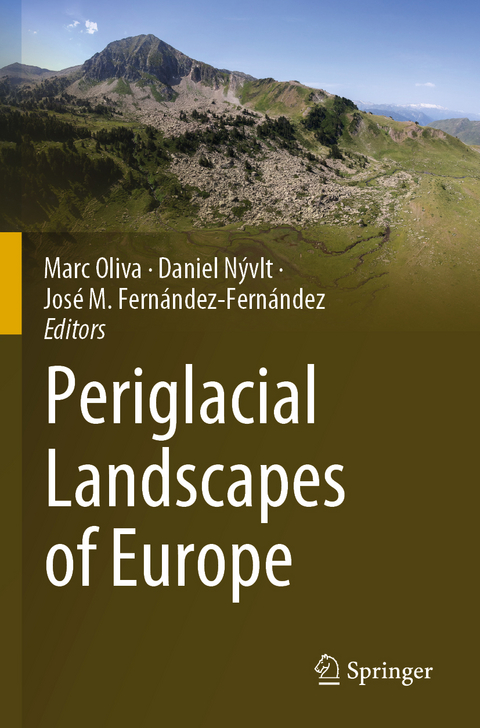
Periglacial Landscapes of Europe
Springer International Publishing (Verlag)
978-3-031-14897-2 (ISBN)
This book comprehensively presents the geography of landforms linked to periglacial processes across Europe. The landscape of the European cold climate regions, both at high latitudes and in mountainous environments, represent the lingering, minimal expression of the glaciers. In addition, periglacial elements can be found in temperate regions, where temperatures no longer favor periglacial processes, so landforms are therefore inherited from previous cold phases.
The book is divided into five parts: an introductory section on climate variability responsible for periglacial dynamics across Europe; a second part including 3 blocks on periglacial landforms in southern, central and northern Europe; and a final chapter providing a more general perspective on the impact of periglacial processes on the landscape of Europe.The book offers a valuable reference guide for scientists from all disciplines interested in cold climate processes, as well as readers outside academia (territorial managers, environmentalists, mountaineers, politicians, engineers, etc.).
Marc Oliva holds a Ph.D. in Geography from the Universitat de Barcelona, where he leads a research group on Antarctic, Arctic, and Alpine Environments. He has participated in eight expeditions to Antarctica and four to the High Arctic. Apart from the Polar Regions, he has also conducted research in other mountain regions (Rocky Mountains, Alps, N Iceland, Pamir, Tien Shan, Pyrenees, Cantabrian Mountains), which have provided him a wide comprehension of earth surface processes in cold climate environments. His research interests include the study of geomorphological processes and past environments and climate in the Polar Regions and high mountains using a wide range of natural records (glacial, periglacial, lacustrine).
Daniel Nývlt holds a Ph.D. in Physical geography from the Charles University in Prague. He currently works as Associate Professor at the Department of Geography, Masaryk University in Brno, where he is the Head of the Czech Antarctic Research Programme and the Polar-Geo-Lab. He has scientifically worked at five continents, but focuses principally on Polar and Alpine environments. He has participated or led eleven expeditions to Antarctica and seven expeditions to the High Arctic (Svalbard, Greenland). His research interest covers wide range of geoscientific disciplines of Quaternary Geology and Physical Geography from sedimentology, glacial geology, permafrost science, geomorphology, paleoclimatology, through stratigraphy, and glaciology toward ecology, geochronology, natural hazards, and remote sensing.
José M. Fernández-Fernández holds a Ph.D. in Geography from the Universidad Complutense de Madrid, where he is currently Assistant Professor and member of the High Mountain Physical Geography research group. He has done fieldwork in several mountains of Iceland (Tröllaskagi Peninsula), the Iberian Peninsula (Iberian Range, Central Range, NW Ranges, Cantabrian Mountains, and Pyrenees) and Antarctica (South Shetland Islands). His research is focused on the glacial evolution at different time scales, the origin and dynamics of rock glaciers and debris-covered glaciers, and the application of surface exposure dating and geographic information systems to achieve palaeoenvironmental reconstructions.
Chapter 1 - Introduction.- Part 1 - Regional Setting.- Chapter 2. Quaternary climate variability and periglacial dynamics.- Chapter 3 - Periglacial Landforms Across Europe.- Part 2 - Periglacial Landforms in Southern Europe.- Chapter 4. The Iberian Peninsula.- Chapter 5. The Italian Peninsula.- Chapter 6. The Balkans (without Carpathians).- Chapter 7. The Anatonian Peninsula.- Chapter 8. The Mediterranean islands.- Part 3 - Periglacial Landforms in Central and Eastern Europe.- Chapter 9. European Alps.- Chapter 10. The Central European Variscan ranges.- Chapter 11. The Carpathians.- Chapter 12. The North European Plain.- Part 4 - Periglacial Landforms in Northern Europe.- Chapter 13. Great Britain and Ireland.- Chapter 14. Scandinavia.- Chapter 15. Iceland.- Part 5 - Conclusions.- Chapter 16. The periglaciation of Europe.
| Erscheinungsdatum | 04.01.2024 |
|---|---|
| Zusatzinfo | XII, 523 p. 109 illus., 104 illus. in color. |
| Verlagsort | Cham |
| Sprache | englisch |
| Maße | 155 x 235 mm |
| Gewicht | 808 g |
| Themenwelt | Naturwissenschaften ► Geowissenschaften ► Geologie |
| Schlagworte | Cold-climate • geomorphology • Glaciers • permafrost • Seasonal frost |
| ISBN-10 | 3-031-14897-5 / 3031148975 |
| ISBN-13 | 978-3-031-14897-2 / 9783031148972 |
| Zustand | Neuware |
| Haben Sie eine Frage zum Produkt? |
aus dem Bereich


